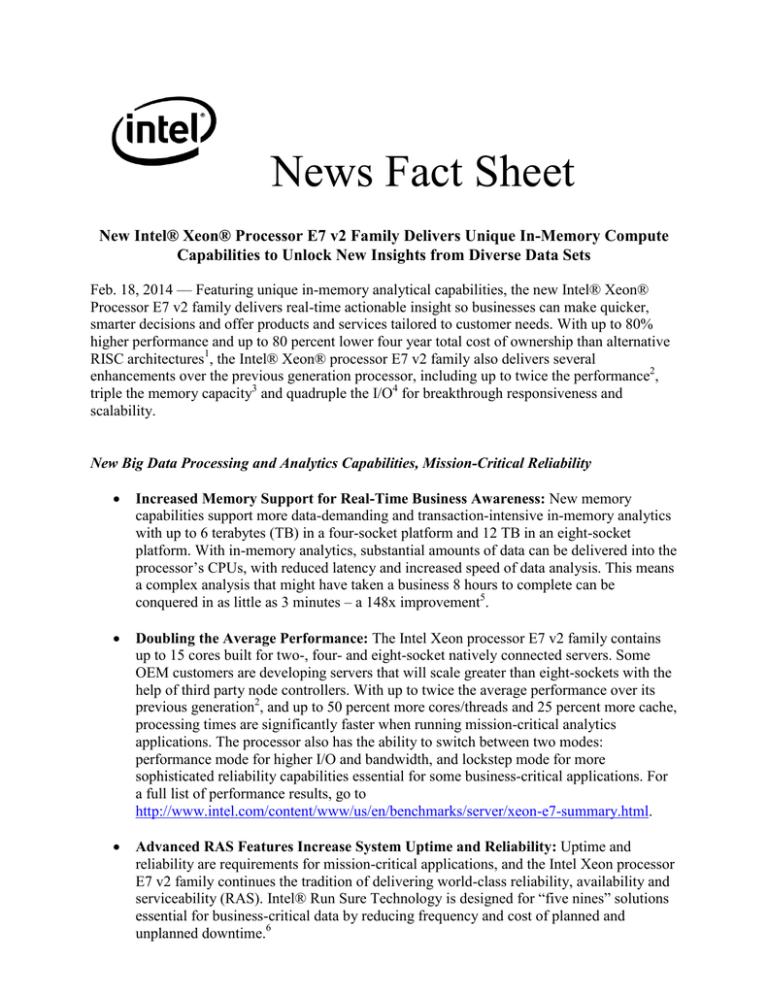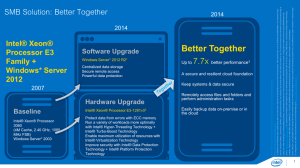
News Fact Sheet
New Intel® Xeon® Processor E7 v2 Family Delivers Unique In-Memory Compute
Capabilities to Unlock New Insights from Diverse Data Sets
Feb. 18, 2014 — Featuring unique in-memory analytical capabilities, the new Intel® Xeon®
Processor E7 v2 family delivers real-time actionable insight so businesses can make quicker,
smarter decisions and offer products and services tailored to customer needs. With up to 80%
higher performance and up to 80 percent lower four year total cost of ownership than alternative
RISC architectures1, the Intel® Xeon® processor E7 v2 family also delivers several
enhancements over the previous generation processor, including up to twice the performance2,
triple the memory capacity3 and quadruple the I/O4 for breakthrough responsiveness and
scalability.
New Big Data Processing and Analytics Capabilities, Mission-Critical Reliability
Increased Memory Support for Real-Time Business Awareness: New memory
capabilities support more data-demanding and transaction-intensive in-memory analytics
with up to 6 terabytes (TB) in a four-socket platform and 12 TB in an eight-socket
platform. With in-memory analytics, substantial amounts of data can be delivered into the
processor’s CPUs, with reduced latency and increased speed of data analysis. This means
a complex analysis that might have taken a business 8 hours to complete can be
conquered in as little as 3 minutes – a 148x improvement5.
Doubling the Average Performance: The Intel Xeon processor E7 v2 family contains
up to 15 cores built for two-, four- and eight-socket natively connected servers. Some
OEM customers are developing servers that will scale greater than eight-sockets with the
help of third party node controllers. With up to twice the average performance over its
previous generation2, and up to 50 percent more cores/threads and 25 percent more cache,
processing times are significantly faster when running mission-critical analytics
applications. The processor also has the ability to switch between two modes:
performance mode for higher I/O and bandwidth, and lockstep mode for more
sophisticated reliability capabilities essential for some business-critical applications. For
a full list of performance results, go to
http://www.intel.com/content/www/us/en/benchmarks/server/xeon-e7-summary.html.
Advanced RAS Features Increase System Uptime and Reliability: Uptime and
reliability are requirements for mission-critical applications, and the Intel Xeon processor
E7 v2 family continues the tradition of delivering world-class reliability, availability and
serviceability (RAS). Intel® Run Sure Technology is designed for “five nines” solutions
essential for business-critical data by reducing frequency and cost of planned and
unplanned downtime.6
Heightened Security for Enhanced Data Integrity: Hardware-embedded security has
been strengthened in Intel’s new product family, creating a more secure system to
transfer data and conduct advanced analytics. The new features include Intel® Data
Protection Technology with Secure Key and Intel® Platform Protection Technology with
OS Guard for faster and more secure encryption, and improved protection against
malware.
Processor Number
CPU
Frequency L3 Cache
Power
(GHZ)
Number of Cores
For >=167, 8, 4 & 2 Socket Scalable Servers
Intel®
QPI Link
Speed
Intel® Xeon® Processor
E7-8893 v2
Intel® Xeon® Processor
E7-8891 v2
Intel® Xeon® Processor
E7-8880L v2
Intel® Xeon® Processor
E7-8857 v2
Intel® Xeon® Processor
E7-8890 v2
Intel® Xeon® Processor
E7-8880 v2
Intel® Xeon® Processor
E7-8870 v2
Intel® Xeon® Processor
E7-8850 v2
3.4
37.5 MB
6
155 W
8.0 GT/s
3.2
37.5 MB
10
155 W
8.0 GT/s
2.2
37.5 MB
15
105 W
8.0 GT/s
3.0
30 MB
12
130 W
8.0 GT/s
2.8
37.5 MB
15
155 W
8.0 GT/s
2.5
37.5 MB
15
130 W
8.0 GT/s
2.3
30 MB
15
130 W
8.0 GT/s
2.3
24 MB
12
105 W
7.2 GT/s
Intel® Xeon® Processor
E7-4890 v2
Intel® Xeon® Processor
E7-4880 v2
Intel® Xeon® Processor
E7-4870 v2
Intel® Xeon® Processor
E7-4860 v2
Intel® Xeon® Processor
E7-4850 v2
Intel® Xeon® Processor
E7-4830 v2
Intel® Xeon® Processor
E7-4820 v2
Intel® Xeon® Processor
E7-4809 v2
2.8
37.5 MB
15
155 W
8.0 GT/s
2.5
37.5 MB
15
130 W
8.0 GT/s
2.3
30 MB
15
130 W
8.0 GT/s
2.6
30 MB
12
130 W
8.0 GT/s
2.3
24 MB
12
105 W
7.2 GT/s
2.2
20 MB
10
105 W
7.2 GT/s
2.0
16 MB
8
105 W
7.2 GT/s
1.9
12 MB
6
105 W
6.4 GT/s
Intel® Xeon® Processor
E7-2890 v2
Intel® Xeon® Processor
E7-2880 v2
Intel® Xeon® Processor
E7-2870 v2
Intel® Xeon® Processor
E7-2850 v2
2.8
37.5 MB
15
155 W
8.0 GT/s
2.5
37.5 MB
15
130 W
8.0 GT/s
2.3
30 MB
15
130 W
8.0 GT/s
2.3
24 MB
12
105 W
7.2 GT/s
For 4 & 2 Socket Scalable Servers
For 2 Socket Scalable Servers
CONTACT:
Radoslaw Walczyk
408-765-0012
radoslaw.walczyk@intel.com
Copyright © 2014 Intel Corporation. All rights reserved. Intel, the Intel logo, Xeon and Xeon logo are trademarks or registered trademarks of
Intel Corporation or its subsidiaries in the United States and other countries.
*Other names and brands may be claimed as the property of others.
Software and workloads used in performance tests may have been optimized for performance only on Intel microprocessors. Performance tests,
such as SYSmark and MobileMark, are measured using specific computer systems, components, software, operations and functions. Any change
to any of those factors may cause the results to vary. You should consult other information and performance tests to assist you in fully evaluating
your contemplated purchases, including the performance of that product when combined with other products.
Results have been estimated based on internal Intel analysis and are provided for informational purposes only. Any difference in system hardware
or software design or configuration may affect actual performance.
Intel does not control or audit the design or implementation of third party benchmarks or Web sites referenced in this document. Intel encourages
all of its customers to visit the referenced Web sites or others where similar performance benchmarks are reported and confirm whether the
referenced benchmarks are accurate and reflect performance of systems available for purchase.
Relative performance is calculated by assigning a baseline value of 1.0 to one benchmark result, and then dividing the actual benchmark result for
the baseline platform into each of the specific benchmark results of each of the other platforms, and assigning them a relative performance
number that correlates with the performance improvements reported.
The cost reduction scenarios described in this document are intended to enable you to get a better understanding of how the purchase of a given
Intel product, combined with a number of situation-specific variables, might affect your future cost and savings. Circumstances will vary and
there may be unaccounted-for costs related to the use and deployment of a given product. Nothing in this document should be interpreted as
either a promise of or contract for a given level of costs.
SPEC, SPECint, are trademarks of the Standard Performance Evaluation Corporation. See http://www.spec.org for more information.
Intel processor numbers are not a measure of performance. Processor numbers differentiate features within each processor family, not across
different processor families: Go to:
Learn About Intel® Processor Numbers
Intel's compilers may or may not optimize to the same degree for non-Intel microprocessors for optimizations that are not unique to Intel
microprocessors. These optimizations include SSE2, SSE3, and SSE3 instruction sets and other optimizations. Intel does not guarantee the
availability, functionality, or effectiveness of any optimization on microprocessors not manufactured by Intel.
Microprocessor-dependent optimizations in this product are intended for use with Intel microprocessors. Certain optimizations not specific to
Intel microarchitecture are reserved for Intel microprocessors. Please refer to the applicable product User and Reference Guides for more
information regarding the specific instruction sets covered by this notice.
Notice revision #20110804
1.
2.
3.
4.
Up to 80% leadership performance on Xeon E7 v2 over IBM POWER* 7+ at ~80% lower TCO claim based on Intel estimated
SPECint*_rate_base2006 results and pricing of comparable 4-socket rack server using Intel® Xeon® processor E7-4890 v2 (37.5M
Cache, 2.8 GHz, 15-Cores) to IBM POWER*750 using POWER7+ (80M Cache, 4.0 GHz, 8-Cores) as of December 2013.
a.
SPECint_rate_base2006 benchmark results:
i. 4-chip IBM POWER7+ (1230 baseline score) source: http://www.spec.org/cpu2006/results/res2013q3/cpu200620130805-26129.html
ii. 4-chip Intel Xeon processor E7-4890 v2 (2280 baseline score estimated)
b. Estimated street pricing:
i. 4-chip Intel Xeon Processor E7-4890 v2 platform Intel estimated price of $51,237 with 4x Intel Xeon processor
E7-4890 v2 processors, 256 GB memory, 2 HDDs.
ii. 4-chip IBM Power 750 Express Pricing of $177,290: 4 x 4.0 GHz POWER7+* processors, 256GB memory, 2
HDDs. Source: IBM United States Prices 113-026, dated February 5, 2013 (hardware list prices). http://www01.ibm.com/common/ssi/rep_ca/6/897/ENUS113-026/ENUS-113-026-LIST_PRICES_2013_02_05.PDF.
c.
Up to 80% better 4-year TCO through lower software costs claim based on Intel internal total cost of ownership tool
normalizing integer throughput performance between the two options.
i. Calculations includes analysis based on performance, power, cooling, electricity rates, operating system and
annual support/license costs on Red Hat* Enterprise LINUX for POWER* or 32-/64-bit x86 at
https://www.redhat.com/apps/store/server/ plus estimated server costs.
ii. Assumptions include 42U racks, $0.10 per kWh, cooling costs 2x average server power consumption costs,
Alinean* assumptions of $500 per server maintenance and $30 per server networking costs, average real estate
cost per year from VMware* planning tool at $310 per sq. foot * 10 sq. feet per rack divided by the number of
servers per rack, 60% CPU utilization and PUE of 2.0.
Up to 2x average generational performance gain based on results of six key industry-standard workloads: SPECint*_rate_base2006+,
SPECfp*_rate _base2006+, brokerage on-line transaction processing (OLTP) database workload, warehouse supply chain OLTP
database workload, STREAM memory bandwidth and LINPACK GFLOPS. Configurations: 4-socket server using Intel® Xeon®
processor E7-4890 v2 (new processor) vs. E7-4870 (previous generation processor). Source; Intel internal testing as of November
2013.
Up to 3x memory capacity increase based on a 4-socket natively-connected platform: Intel® Xeon® processor E7 family supports
64DIMMS, max memory per DIMM of 32GB RDIMM; Intel® Xeon® processor E7 v2 family supports 96DIMMs, max memory per
DIMM of 64GB RDIMM. This enables a 3x increase in memory.
Up to 4x I/O bandwidth based on On a 4-socket natively-connected platform: Intel® Xeon® processor E7 family supports 64DIMMS,
max memory per DIMM of 32GB RDIMM; Intel® Xeon® processor E7 v2 family supports 96DIMMs, max memory per DIMM of
64GB RDIMM. This enables a 3x increase in memory.
5.
Test results based on an internal 10 TB database Proof of Performance and Scalability (POPS) benchmark with IBM® DB2® 10.1
running on a 4-socket Intel® Xeon® processor E7-4870 with 1,024 GB of memory, and DB2 10.5 with BLU Acceleration running on
a 4-socket Intel Xeon processor E7-4890 with 1,024 GB of memory. Both systems were configured with IBM® XIV® Gen3 storage
attached with 8 Gbps Fibre Channel (FC) via 8 GB SAN switch with 111 TB total raw space (2 TB x 12 disks/pModule x 11 XIV
modules). Performance improvement figures are cumulative of all queries in the workload. Individual results will vary depending on
individual workloads, configurations, and conditions.
Source: Intel internal testing as of February 2014. Configuration details:
a.
Common: SuSE* LINUX Enterprise Server 11 SP3 x86-64, IBM DB2* 10.1 FP1 GA or 10.5 FP1 with BLU*
b. IBM DB2 10.1 + Intel Xeon Processor E7-4870 using IBM Gen3 XIV FC SAN solution
c.
IBM DB2 10.5 with BLU Acceleration + Intel Xeon Processor E7-4870 using tables in-memory (1TB total)
d. IBM DB2 10.5 with BLU Acceleration + Intel Xeon Processor E7-4890 v2 using tables in-memory (1TB total).
For more information, see http://www-01.ibm.com/software/data/db2/linux-unix-windows/db2-blu-acceleration/.
6. Intel® Run Sure Technology: No computer system can provide absolute reliability, availability or serviceability. Requires an Intel®
Xeon® processor E7-8800/4800/2800 v2 product families-based system (or follow-on generations of either.) Built-in reliability
features available on select Intel® processors may require additional software, hardware, services and/or an internet connection.
Results may vary depending upon configuration. Consult your system manufacturer for more details.
7. Third partner node controller required. Not available from Intel.


